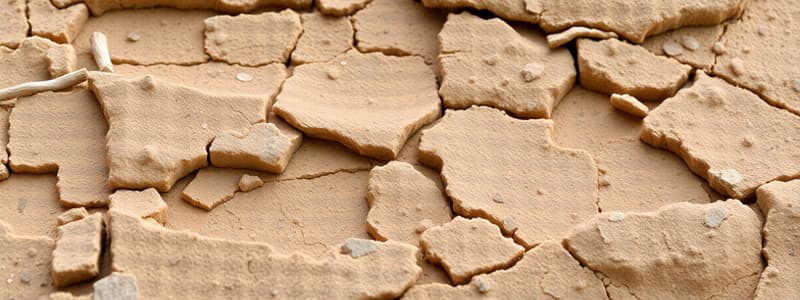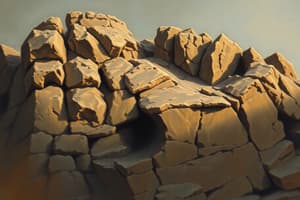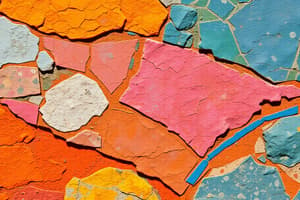Podcast
Questions and Answers
Clastic sedimentary rocks are primarily classified based on what property?
Clastic sedimentary rocks are primarily classified based on what property?
- Color of the rock
- Rock density
- Mineral composition
- Grain size (correct)
What distinguishes breccia from conglomerate?
What distinguishes breccia from conglomerate?
- Color
- Grain size
- Angularity of its clasts (correct)
- Mineral composition
A sandstone composed almost entirely of quartz is called?
A sandstone composed almost entirely of quartz is called?
- Arkose
- Graywacke
- Arenite (correct)
- Lithic wacke
What component is abundant in arkose sandstone?
What component is abundant in arkose sandstone?
Which of the following is a characteristic of lithic wackes?
Which of the following is a characteristic of lithic wackes?
What grain size characterizes sandstones?
What grain size characterizes sandstones?
Which type of sedimentary rock is made of fine mud-size grains?
Which type of sedimentary rock is made of fine mud-size grains?
The mineral composition is key to naming what kind of sedimentary rocks?
The mineral composition is key to naming what kind of sedimentary rocks?
Limestone primarily consists of which mineral?
Limestone primarily consists of which mineral?
Rock salt is primarily made of what mineral?
Rock salt is primarily made of what mineral?
Which mineral primarily forms gypsum rock?
Which mineral primarily forms gypsum rock?
What is chalcedony made of?
What is chalcedony made of?
How do biochemical sedimentary rocks form?
How do biochemical sedimentary rocks form?
What is the primary component of coal?
What is the primary component of coal?
What is the sediment type of conglomerate?
What is the sediment type of conglomerate?
What general category does breccia fit into?
What general category does breccia fit into?
What general category does sandstone fit into?
What general category does sandstone fit into?
What general category does rock salt fit into?
What general category does rock salt fit into?
What general category does gypsum fit into?
What general category does gypsum fit into?
Flashcards
Clastic Sedimentary Rocks
Clastic Sedimentary Rocks
Sedimentary rocks named by grain size, including conglomerate, sandstone, siltstone, and shale.
Sandstone
Sandstone
A clastic sedimentary rock made of sand-sized grains, regardless of mineral composition.
Arenite
Arenite
Sandstone made almost entirely of quartz.
Arkose
Arkose
Signup and view all the flashcards
Lithic Wacke
Lithic Wacke
Signup and view all the flashcards
Chemical Sedimentary Rocks
Chemical Sedimentary Rocks
Signup and view all the flashcards
Limestone
Limestone
Signup and view all the flashcards
Biochemical Sedimentary Rocks
Biochemical Sedimentary Rocks
Signup and view all the flashcards
Breccia
Breccia
Signup and view all the flashcards
Rock Salt
Rock Salt
Signup and view all the flashcards
Coal
Coal
Signup and view all the flashcards
Chert
Chert
Signup and view all the flashcards
Study Notes
Clastic Textures
- Sedimentary rock names like conglomerate, sandstone, siltstone, and shale are based on grain size.
- More precise naming exists within categories, based on sediment features beyond grain size.
- Breccia differs from conglomerate due to clast angularity.
- Sandstone is a clastic rock with sand-sized grains, regardless of mineral composition.
- Arenite is sandstone composed almost entirely of quartz.
- Arkose is sandstone containing significant feldspar mixed with quartz.
- Lithic wackes contain feldspar, quartz, clay, and dark mineral/rock fragments, representing immature sediments.
- Clastic sedimentary rocks are classified by grain size.
- Sandstones consist of sand-sized grains.
- Shale is a layered rock of fine mud-sized grains, too small to see without magnification.
Chemical Textures
- Naming chemical sedimentary rocks depends on their mineral composition.
- Limestones are mostly calcite.
- Rock salt is composed of minerals like halite.
- Gypsum rock contains gypsum.
- Chalcedony contains microcrystalline quartz, with grains too small to distinguish without a microscope.
Biochemical Textures
- Biochemical sedimentary rocks form from past life, like fossils, shells, or plant remains.
- Coal is made of plant remains.
Sedimentary Rock Types
- Conglomerate is a clastic rock, and is composed of gravel coarse grains (>2mm) that are rounded and poorly sorted.
- Breccia is a clastic rock, and is composed of gravel coarse grains (>2mm) that are angular and poorly sorted.
- Sandstone is a clastic rock, and is composed of medium sand grains (0.0625-2mm) that are variable and variably sorted.
- Siltstone is a clastic rock, and is composed of fine grains (0.004-0.0625mm) that are variable and well sorted.
- Shale is a clastic rock, and is composed of extra fine grains (<0.004mm) that are not visible and well sorted.
- Limestone is a biochemical rock, and reacts to HCI and formed in a warm shallow ocean
- Fossiliferous limestone is a biochemical rock containing visible fossils that reacts to HCI and formed in a warm shallow ocean
- Dolostone is a chemical precipitate rock that reacts to HCI only when powered and formed in a saline lagoon
- Travertine is a chemical precipitate rock that is gray or brown, porous and reacts to HCI, formed in an evaporated spring or cave water
- Chalk is a chemical precipitate rock that is white and powdery and reacts to HCI, formed in warm shallow ocean
- Chert is a chemical precipitate rock that has a conchoidal fracture, formed in a deep ocean floor
- Jasper is a chemical precipitate rock that is red in color and has a conchoidal fracture, formed in a deep ocean floor
- Flint is a chemical precipitate rock that is black in color and has a conchoidal fracture, formed in nodules in limestone
- Agate is a chemical precipitate rock that is layered and translucent and has a conchoidal fracture, formed in nodules in volcanic rocks
- Diatomite is a chemical precipitate rock that is white and powdery, formed in lakes in volcanic environments
- Coal is a biochemical rock that is black, soft and has a low density, formed in heavily vegetated swamp
- Rock Salt is a chemical precipitate that taste like salt and has cubic crystals and cleavage, formed in an evaporating water body
- Gypsum rock is a chemical precipitate that is softer than a fingernail formed in an evaporating water body
Uses of Sedimentary Rocks
- Sedimentary rocks serve as building stones, though less durable than igneous/metamorphic types.
- They are used in construction, including sand and gravel for concrete and asphalt.
- Sedimentary rocks provide economically valuable resources, such as iron ore and aluminum.
Studying That Suits You
Use AI to generate personalized quizzes and flashcards to suit your learning preferences.




